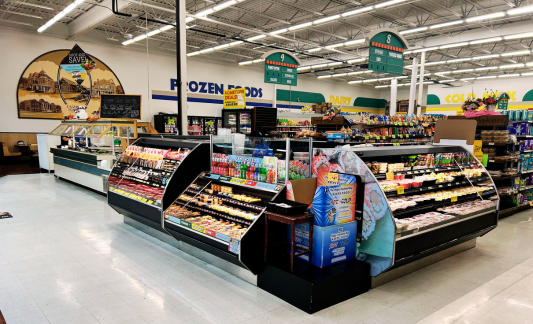Help Isom IGA recover from devasting floods

Do you plan to remodel or retrofit any appliances in your store in the next 36 months? Worried about impending legislation about refrigerants?
If you are a rural grocer and answered yes, then keep reading about the Rural Energy for America Program (REAP), a funding opportunity that provides guaranteed loan financing and grant funding to rural small businesses for renewable energy systems or to make energy efficiency improvements.
"This is one of the single-best opportunities for rural grocers to upgrade their stores and impact their operations. There are opportunities to address future refrigerant requirements, improve operations, and improve profit," said Jonathan Tan, co-founder of Ratio Institute, a non-profit that works with over 1,000 grocery stores and chains to create store-level and enterprise sustainability solutions.
Phasing out hydrofluorocarbons (HFCs) is part of the EPA's impending legislation that is already taking effect in states like California, New York, Vermont, and Washington. The cost of switching to an HFC-free cooling system will only go up as the deadline nears, so experts recommend taking energy efficient steps, like putting doors on open display cases, now. Taking advantage of utility rebates and grant funding can help reduce the cost of compliance significantly.
Many IGA retailers have applied or are in the process of applying for REAP. We detailed how to get started in the fall webinar, How An Energy Grant Can Upgrade Your Store, which you can watch and find a recap of here.
Given that $2 billion has been allocated for the current fiscal year and IGA members are often great candidates for the funding, we asked Tan for the inside scoop and answers to retailers' most common questions.
To Do:
- Click here to contact IGA and Ratio Institute with questions or to get started
- Access the webinar with IGA CEO John Ross and Ratio Institute Co-founder Peter Cooke
- Complete Ratio Institute's benchmarking survey to determine where your store is consuming the most energy
How long do retailers have left to apply for REAP?
There are three more application submittal opportunities this year:
- March 31, 2024
- June 30, 2024
- September 30, 2024
Applications submitted by March 31 will have three chances to be selected, since applications not granted in a particular quarter automatically get submitted for the next quarter. The earlier we complete and submit an application, the higher the probability the project gets funded.
How will this grant help retailers prepare for new regulations coming their way?
Funds can be used for any project where an energy reduction can be substantiated or for renewable energy projects, which is why we recommend considering REAP if you plan any remodel or retrofit in next 36 months.
Thus, upgrading refrigeration systems, refrigerants, and equipment can not only reduce operational costs, but it can help address pending action from the AIM Act (2020), which orders the production of HFCs to be phased down 79% by 2029 and 85% by 2036.
Are there any new grant stipulations?
There are no new grant stipulations, but the basic eligibility requirements are:
- Your store must be in an eligible area per the USDA map
- The project can provide a reduction in energy consumption or generates renewable energy (such as solar)
- Your business must be an SBA
How many independent retailers have applied and what percentage do you anticipate will be approved?
As of the last deadline (December 31, 2023), Ratio Institute has submitted eight applications for independent retailers. Those eight applications were for over $4.5 million in projects and over $2.2 million in grant funds.
The projects included (but are not limited to):
- Refrigerant system upgrades
- Refrigerated case upgrades
- New refrigeration racks
- Refrigerant gas change-outs
- Adding doors to existing open cases
- HVAC upgrades
- Retiring oil furnaces with heat pumps
- Lighting upgrades
- Control upgrades and advanced control systems
- Solar project
All projects moving forward will be state dependent, scope dependent, and based on when an application is submitted. In general, we expect a probability greater than 50% of being funded.
In short, there is money available and the USDA wants to give it to rural grocers to help make their stores more energy efficient. With the impending regulations coming, there's no reason not to apply.
The earlier you apply, the better. If you submit a project application in September, it will be subject to remaining funds in the program. We expect this to reduce the chances of a project being selected and encourage retailers to start the application process now.
At present, we expect to submit more than 30 projects for Q1 (by the March 31 deadline) with total project costs of more than $15 million and grant funding of more than $7 million. Ratio Institute's goal is to support more than 100 IGA member locations with applications before the September 30 final application deadline. This would be more than $50 million in projects and more than $25 million in grants.
What other advice do you have for IGA members?
- Apply for as much money as possible. Retailers do not have to accept all funds granted. Once approved, more money cannot be added to the funding request.
- If you have already started a project, we can apply for funding for any portion of a project where monies have not been paid to vendors or contractors. For example, if you have a $1 million project and already made a downpayment $250,000, we can apply for grant monies on the balance of $750,000 of the project.
- You must wait to receive an accepted application letter before spending money to ensure all portions of the project are eligible for grant monies.
What are the steps to determining eligibility and applying for REAP?
The first step to is to determine your store's eligibility. The REAP grant is for stores in communities of less than 50,000 people, so plug in your store address to the USDA-eligible rural area map here. You should have less than 500 employees and less than $40 million in annual revenue per store location.
If your store is eligible, the next step is to complete an energy audit. As IGA’s sustainability partner, Ratio Institute can do that at a reduced cost for Independent Grocers Alliance members ($500 invoiced by IGA). They will identify where your store is consuming the most energy and propose solutions to solve them. Complete the benchmarking survey, which takes about 15 minutes, and provide us with a minimum of 12 months’ worth of the following bills:
- Electric bills
- Gas (heating) bills
- Water and sewer bills
- All solid waste and recycling bills or credits
- Any other municipal services bills
After Ratio Institute receives the assessment and bills, we will calculate:
- Realized savings: value in dollars and avoided greenhouse gas (GHG) of existing in-place items
- Potential savings: value in dollars and GHG of process and/or upgrades to employ or deploy
- Best practices: value of additional technologies and refrigerant improvements in dollars and GHG
- Operational comparisons: how your store compares to a typical store of your size, plus other insights and recommendations based on these metrics
Once the energy audit is complete, you can deliver it to your contractor to estimate a quote for recommended services. We can assist in the Scope of Work (SOW) development and consult with your contractor/vendor as part of the process to create the best project specific to each retailer's needs.
Finally, you will submit the energy audit and scope to the USDA via the application. Alternatively, Ratio Institute can submit the grant application on your behalf (Ratio Institute charges $1,000 for this service, which covers the $500 for the report and $500 for the initial application, plus 10% of the project costs based only on grant approval).
Previous Story
← Get To Know 2024 IGA Retailers of the Year: Part I
You May Also Like
These Stories on Sustainability
Oct 28, 2025 5:11:03 PM |
3 min read
Apr 8, 2025 10:22:29 AM |
5 min read



No Comments Yet
Let us know what you think